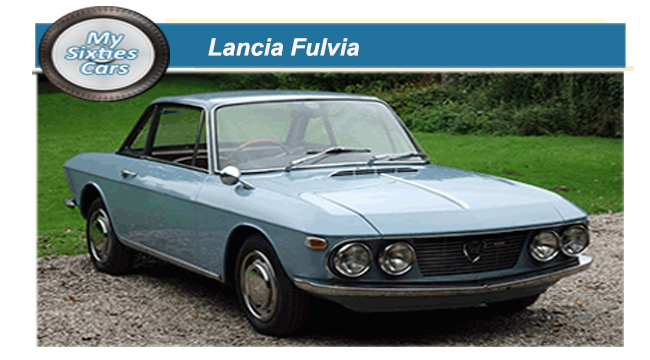
The Fulvi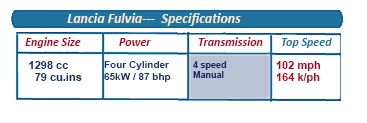 a, initially launched in saloon format, was the first front-wheel drive Lancia, and it turned away from the usual V-shaped engine by using an alloy flat-four 'boxer' unit.
a, initially launched in saloon format, was the first front-wheel drive Lancia, and it turned away from the usual V-shaped engine by using an alloy flat-four 'boxer' unit.
It did not stop there. The Flavia had disc brakes on all wheels, with vacuum assistance and a dual hydraulic system for extra safety, although its styling was best described as" ordinary".
The Fulvia again used front wheel drive, while its brakes were also upgraded from the Flavia.
Like its 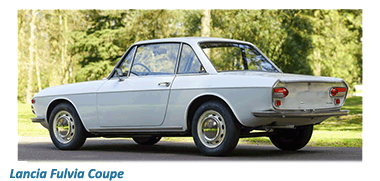 stable mates, an number of Fulvia configurations were available, with no less than fifteen variations to choose from at some time during its production run.
stable mates, an number of Fulvia configurations were available, with no less than fifteen variations to choose from at some time during its production run.
The 1963 Fulvia, a boxy sedan (saloon), had been a very smooth package, unusual for its high revving 1,298-cc) V4 engine, four-wheel disc brakes, and transverse-leaf-spring front suspension.
Once the saloon had established itself, Lancia started to introduce different variants. Next came the Fulvia coupe in 1965, which cosmetically shared no similarities with the saloon at all.
![]()
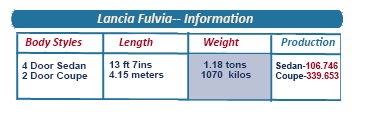 able 2+2, the Fulvia Coupe came fitted with aluminum doors, bonnet and boot lid which served the dual function of reducing weight and improving agility, this meant that even with a standard 1216cc engine generating 80 bhp fitted, those first Coupes were reasonably quick.
able 2+2, the Fulvia Coupe came fitted with aluminum doors, bonnet and boot lid which served the dual function of reducing weight and improving agility, this meant that even with a standard 1216cc engine generating 80 bhp fitted, those first Coupes were reasonably quick.
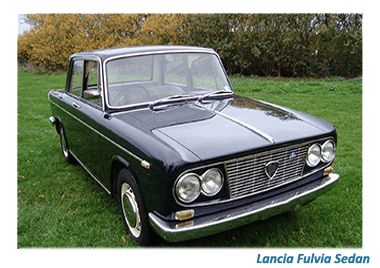 It soon became obvious that the Lancia Fulvia could handle more power, which is why a stream of more powerful editions began to be released.
Lancia had always been a force to be reckoned with in motorsports, and the Fulvia Coupe Rally HF, with it 96-cubic-inch (1,584-cc), one 15-bhp (86-kW) engine, was a serious competitor on the rally circuits.
Great pride, as well as commercial recognition, was soon to follow with the Fulvia HF, winning the International Championship for Manufacturers in 1972, ironically forcing Fiat into second place and even Porsche into third.
Lancia had always been a force to be reckoned with in motorsports, and the Fulvia Coupe Rally HF, with it 96-cubic-inch (1,584-cc), one 15-bhp (86-kW) engine, was a serious competitor on the rally circuits.
It soon became obvious that the Lancia Fulvia could handle more power, which is why a stream of more powerful editions began to be released.
Lancia had always been a force to be reckoned with in motorsports, and the Fulvia Coupe Rally HF, with it 96-cubic-inch (1,584-cc), one 15-bhp (86-kW) engine, was a serious competitor on the rally circuits.
Great pride, as well as commercial recognition, was soon to follow with the Fulvia HF, winning the International Championship for Manufacturers in 1972, ironically forcing Fiat into second place and even Porsche into third.
Lancia had always been a force to be reckoned with in motorsports, and the Fulvia Coupe Rally HF, with it 96-cubic-inch (1,584-cc), one 15-bhp (86-kW) engine, was a serious competitor on the rally circuits.
![]()
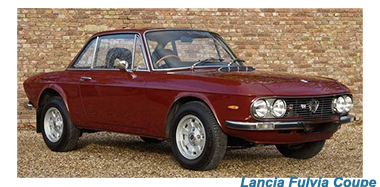 Fulvia’s commercial success the model couldn't prevent its parent from being consumed by Fiat in 1969, though happily the proud Lancia name was allowed to live on.
The Fulvia coupe version remained in production under Fiat until 1976 going on to become an icon in the rallying world during its lifetime.
When the final chapter on the Fulvia is written, the Lancia Fulvia Coupe will go down as one of the great driving machines of the Sixties.
Fulvia’s commercial success the model couldn't prevent its parent from being consumed by Fiat in 1969, though happily the proud Lancia name was allowed to live on.
The Fulvia coupe version remained in production under Fiat until 1976 going on to become an icon in the rallying world during its lifetime.
When the final chapter on the Fulvia is written, the Lancia Fulvia Coupe will go down as one of the great driving machines of the Sixties.






